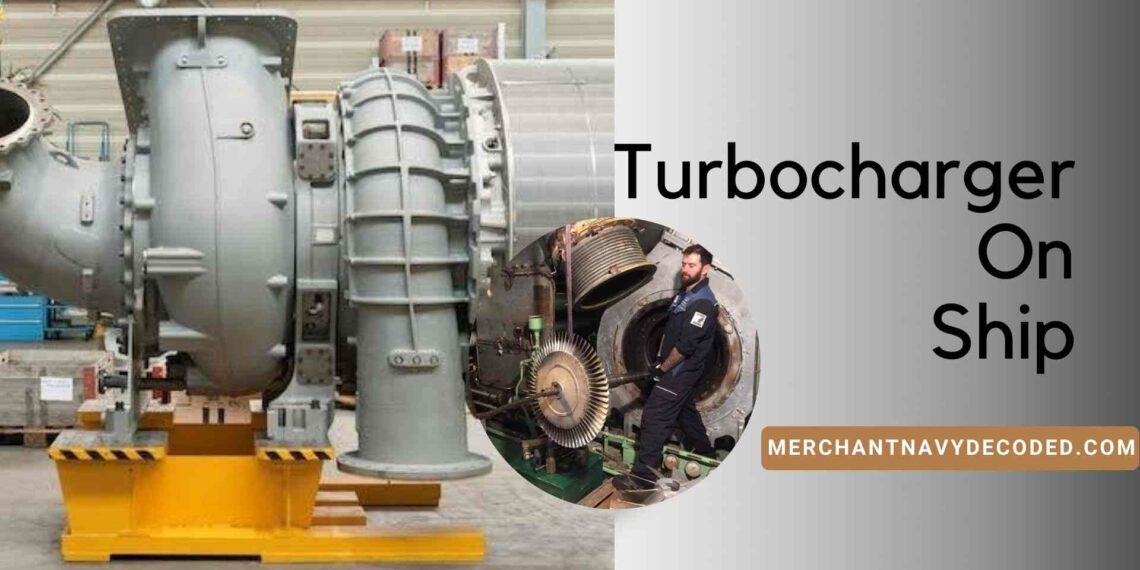Working of Marine Turbocharger on Ship
1:- Overview
In the previous blog, we explored the definition of a turbocharger, its construction, its various types, and the system it operates within, if you haven’t checked it yet, CLICK HERE. In this subsequent blog, we will delve into the working process of turbochargers, strategies for maintaining efficiency, and troubleshooting common issues such as surging and tuning.
2:- How Does a Ship Turbocharger Work
2.1:- Preparation and Checks of Turbocharger
Before firing up your ship’s engine, a proper inspection of the turbocharger is crucial for optimal performance and longevity of turbochargers.
- Lube Oil Inspection
- Verify that the turbocharger’s oil reservoir (if separate) is filled to the manufacturer’s specified level. Confirm the oil pressure is within the normal range using the dedicated gauge. In the case of a shared lubrication system with the main engine, ensure the engine’s oil system is primed and ready.
- Cooling Water Verification
- Open the cooling water supply valve to the turbocharger and visually confirm the flow. Use a thermometer to ensure the cooling water temperature is within the manufacturer’s recommended parameters.
- Air Intake Inspection
- Thoroughly inspect the air filter for any accumulated dirt, debris, or signs of damage. Clean or replace the filter as needed. Additionally, examine the air intake duct to ensure it’s clear of obstructions that could restrict airflow.
- Visual and Manual Checks:
- Conduct a visual inspection of the entire turbocharger assembly, looking for any leaks, cracks, or loose components. Manually rotate the shaft (if accessible) to check for excessive play or unusual sounds.
3:- Starting Procedure of Turbocharger
Starting a turbocharged engine requires a gentle touch to avoid stressing the components.
- Initial Start-up
- Begin by starting the engine at a low RPM, allowing the lube oil to circulate and gradually reach its optimal operating temperature. This gentle warm-up helps prevent thermal shock and premature wear.
- Gradual Acceleration:
- Slowly increase the engine speed while carefully monitoring the turbocharger gauges. Keep a close watch on boost pressure, exhaust gas temperature, and bearing temperatures, ensuring they remain within the safe operating limits specified by the manufacturer.
- Auditory Vigilance:
- Listen attentively for any unusual noises coming from the turbocharger during the start-up process. Rattling, grinding, or squealing sounds could indicate potential issues that require immediate attention.
4:- How to Boost the Efficiency of a Turbocharger?
The turbocharger is a masterpiece of engineering, harnessing the energy of exhaust gases to enhance engine performance.
- Exhaust Gas Utilization:
- Hot, high-pressure exhaust gases exiting the engine cylinders are directed into the turbine housing.
- Turbine Rotation:
- The exhaust gases impact the turbine blades, causing the turbine wheel to spin at incredibly high speeds.
- Shared Shaft:
- The turbine wheel is directly connected to a compressor wheel through a common shaft.
- Air Compression:
- As the turbine spins, it drives the compressor wheel, which draws in ambient air and compresses it.
- Boost Pressure:
- The compressed air is then forced into the engine’s intake manifold under pressure, significantly increasing the air density within the cylinders.
- Power Amplification:
- With a greater mass of air available for combustion, the engine can burn more fuel, resulting in a substantial increase in power output and overall efficiency.
5:- Surging of Turbocharger
Turbocharger surging is a concerning phenomenon that can occur under certain conditions, leading to a pulsating sound and potentially damaging vibrations.
5.1:- What is Surging of Turbocharging?
- Surging is a sudden and rapid reversal of airflow within the turbocharger. It happens when the compressor cannot maintain a stable pressure ratio, causing the airflow to fluctuate violently.
5.2:- Causes of Surging of Turbocharger
- Abrupt Changes in Engine Load: Sudden acceleration or deceleration can disrupt the airflow, triggering surging.
- Obstructed Air Intake or Exhaust: A clogged air filter, restricted exhaust, or a malfunctioning wastegate can lead to pressure imbalances that induce surging.
- Incorrectly Matched Turbocharger: A turbocharger that is too large for the engine can operate outside its efficient range, making it prone to surging.
5.3:- Effects of Surging of Turbocharging
- Reduced Performance: Surging disrupts the smooth flow of air and fuel, reducing engine power and efficiency.
- Increased Stress: The rapid pressure fluctuations put immense stress on the turbocharger components, potentially leading to premature wear or damage.
- Noise: Surging often produces a distinctive howling or chirping sound.
5.4:- Preventing and Mitigating Surging of Turbocharging
- Smooth Operation: Operate the engine smoothly, avoiding sudden changes in load or speed.
- Maintenance: Keep the air filter clean, ensure the exhaust system is free of obstructions, and verify that the wastegate (if present) is functioning properly.
- Properly Sized Turbocharger: Ensure the turbocharger is appropriately matched to the engine’s size and operating characteristics.
5.5:- In the Event of Surging
- Reduce Load: If surging occurs, immediately reduce the engine load to stabilize the airflow.
- Investigate and Repair: Identify and address the root cause of the surge. This may involve cleaning or replacing the air filter, checking the exhaust system, or adjusting the wastegate.
6:- Exhaust Gas Tuning of a Turbocharger
Exhaust gas tuning is a sophisticated technique employed on ships to enhance turbocharger performance. By manipulating the exhaust gas flow, engineers can maximize energy transfer to the turbine, leading to improved responsiveness, efficiency, and power output.
6.1:- Methods of Exhaust Gas Tuning:
- Pulse Converter Manifolds:
- Purpose: To amplify the pressure pulses created by the engine’s exhaust strokes.
- Mechanism: These manifolds are designed with specific geometries (lengths and diameters) to create constructive interference between exhaust pulses, resulting in stronger pressure waves that drive the turbine more forcefully.
- Variable Geometry Turbines (VGT):
- Purpose: To adjust the turbine geometry to match the engine’s operating conditions.
- Mechanism: VGTs feature movable vanes or flaps that control the flow of exhaust gas onto the turbine wheel. At low engine speeds, the vanes direct the flow to a smaller area, increasing gas velocity and improving turbine response. At higher speeds, the vanes open up to allow a greater flow rate and prevent excessive back pressure.
- Electronic Control Systems:
- Purpose: To optimize exhaust gas tuning in real-time based on engine parameters and operating conditions.
- Mechanism: Sophisticated electronic control systems monitor various engine parameters (e.g., RPM, load, exhaust temperature) and adjust the wastegate position or VGT vane angles accordingly. This allows for dynamic tuning, ensuring optimal performance across the engine’s operating range.
7:- Turbocharger Failure
Turbocharger failures can be costly and disruptive, causing engine downtime and potentially affecting a ship’s schedule. Understanding the common causes and knowing how to handle them is essential.
7.1:- Causes of Turbocharger Failure
- Lubrication Issues:
- Insufficient oil supply
- Contaminated oil
- Clogged oil passages
- Faulty oil pump
- Foreign Object Damage (FOD):
- Ingestion of debris through the air intake or exhaust
- Impact damage to the blades
- Overheating:
- Insufficient cooling water
- High exhaust gas temperatures
- Excessive engine load
- Over-speeding:
- Malfunctioning wastegate or VGT
- Excessive engine RPM
7.2:- Consequences of Turbocharger Failure
- Reduced Power: The engine will lose significant power due to the lack of boost pressure.
- Increased Fuel Consumption: The engine will become less efficient, requiring more fuel to maintain the same speed.
- Increased Emissions: The combustion process may not be as complete, leading to higher emissions of pollutants.
- Engine Damage: In severe cases, turbocharger failure can lead to engine damage due to excessive heat or debris entering the cylinders.
7.3:- Running an Engine with Turbocharger Failure:
- Limited Operation: If the turbocharger fails, the engine can still operate, but with reduced power and efficiency.
- Bypass (If Possible): Some turbochargers have a bypass valve that allows the exhaust gases to bypass the turbine, enabling the engine to run without boost pressure.
- Limit Engine Speed and Load: To minimize further damage, limit engine speed and load until repairs can be made.
- Seek Assistance: If the turbocharger fails at sea, contact the nearest port for assistance and arrange for repairs.
7.4:- Preventive Maintenance:
The best way to avoid turbocharger failures is through a rigorous preventive maintenance program:
- Regular Inspections: Conduct thorough inspections of the turbocharger during routine maintenance.
- Oil and Filter Changes: Follow the manufacturer’s recommendations for oil and filter change intervals.
- Cleaning: Clean compressors and turbine blades regularly to prevent fouling.
- Monitoring: Pay close attention to turbocharger gauges and address any abnormal readings promptly.
Disclaimer :- The opinions expressed in this article belong solely to the author and may not necessarily reflect those of Merchant Navy Decoded. We cannot guarantee the accuracy of the information provided and disclaim any responsibility for it. Data and visuals used are sourced from publicly available information and may not be authenticated by any regulatory body. Reviews and comments appearing on our blogs represent the opinions of individuals and do not necessarily reflect the views of Merchant Navy Decoded. We are not responsible for any loss or damage resulting from reliance on these reviews or comments.
Reproduction, copying, sharing, or use of the article or images in any form is strictly prohibited without prior permission from both the author and Merchant Navy Decoded.



